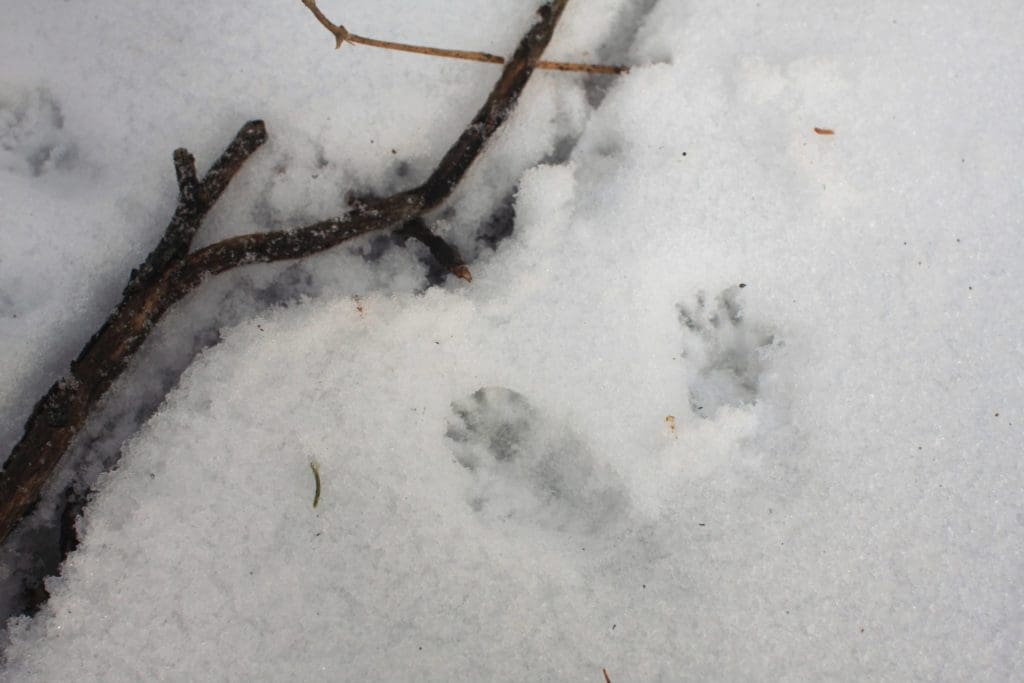Sometimes all the evidence an animal leaves behind to show it was there is tracks or scat. These are important clues in figuring out who you share a landscape with.
At a series of workshops in Canmore, Alta., this past January, Y2Y and Fiera Biological Consulting taught community members in the Bow Valley some ways to improve wildlife tracking skills.
Professional wildlife tracker and wildlife biologist Joseph Litke shared his top tips and tricks for identifying those tracks you see, whether they are in your backyard, public lands or a major wildlife corridor.
For folks just learning how to identify tracks, getting a good photo can make a difference when getting expert help. There are a number of apps available where others weigh in on what track you think you saw. Uploading a variety of high quality, well composed photos of that mysterious wildlife track can help them help you.
Getting great wildlife track photos can make a difference when it comes to conservation, too. Some of Y2Y’s projects rely on information shared from community members.
For example our partner project with Wolverine Watch uses photos and locations submitted by winter recreationists to help find out where wolverines might be denning in southeast British Columbia and Alberta’s mountain parks. This drives better decision making when it comes to habitat planning. You can help! Learn more about the project and how to submit your track observations.
Tip 1: Have a size reference in your photos
Joseph says carrying a small ruler is helpful in these situations, but not always necessary. People use coins, their hands or other objects to provide a consistent size scale in the photos.
The first photo should be close-up with detail on the toes and print itself.
Tip 2: Zoom out and get the track pattern
Pull back a bit and get a photo that shows more than a single footprint. Instead, try to capture the pattern of the track, or a few steps. You want to get a photo that shows how the track repeats.
Tip 3: Show the habitat
Get a photo that shows the track as well as the surrounding landscape and habitat. This helps fill in a bit more about where the track is and the species that may have made it.
GET EXPERT HELP
Looking for help in identifying a wildlife track? Here are some places to get help identifying those tracks:
- iNaturalist (mobile phone app for iOS and Android)
- NatureLynx (mobile phone app for iOS and Android)
- iTrack (mobile phone app for iOS and Android)
Some popular guidebooks and field guides Joseph recommends:
Friend to Y2Y, David Moskowitz, has a field guide Wildlife of the Pacific Northwest: Tracking and Identifying Mammals, Birds, Reptiles, Amphibians, and Invertebrates. While not specific to Alberta, it offers a very well-rounded approach to tracking, incorporating knowledge of the species, track-patterns, detailed footprints, and include other kinds of wildlife signs, such as scat and scent marking.
Mark Elbroch and Casey McFarland’s book Mammal Tracks and Sign of North America is more encyclopedia than field guide. It is incredibly detailed and comprehensive, and can be overwhelming for beginners. It is, however, a valuable resource for anyone serious about advancing their wildlife track identification and interpretation skills.
For a pretty basic field guide that fits in your pocket, try any of James Halfpenny’s. These are paperback and rather simple: not waterproof, black and white, without photographs. But they are relatively inexpensive, and regionally specific. One Joseph likes is Scats and Tracks of the Rocky Mountains
We are grateful for the financial support provided by our event sponsors: Bass Pro Shops and Cabela’s Outdoor Fund, Alberta Ecotrust, TD Friends of the Environment, and The Calgary Foundation.


